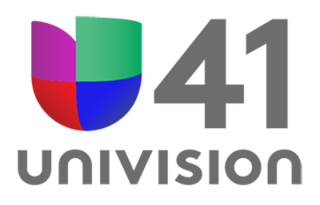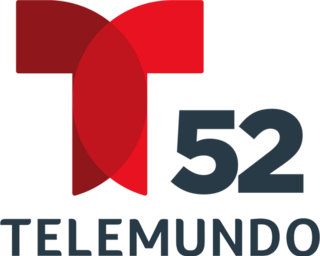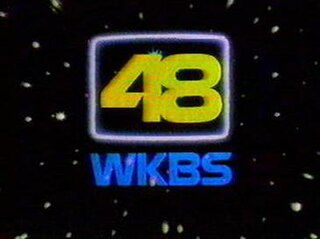KCET is a secondary PBS member television station in Los Angeles, California, United States. It is owned by the Public Media Group of Southern California alongside the market's primary PBS member, Huntington Beach–licensed KOCE-TV. The two stations share studios at The Pointe in Burbank; KCET's transmitter is located atop Mount Wilson in the San Gabriel Mountains.
WFTY-DT is a television station licensed to Smithtown, New York, United States, serving Long Island and owned by TelevisaUnivision. Its main channel broadcasts the True Crime Network; it also rebroadcasts the main channels of its New York City–area Univision and UniMás stations, WXTV-DT and WFUT-DT, from its transmitter in Middle Island, New York.

KLCS is a tertiary PBS member television station in Los Angeles, California, United States. Owned by the Los Angeles Unified School District (LAUSD), it is one of eight television stations in the U.S. that are operated by a local school system. KLCS' studios are located at the former Downtown Magnets High School campus on West Temple Street in downtown Los Angeles, and its transmitter is located atop Mount Wilson.

KMEX-DT is a television station in Los Angeles, serving as the western flagship station of the Spanish-language network Univision. It is owned and operated by TelevisaUnivision alongside Ontario, California–licensed UniMás station KFTR-DT. The two stations share studios on Center Drive in Westchester; KMEX-DT's transmitter is located atop Mount Wilson.
WKBD-TV, branded as Detroit 50, is an independent television station in Detroit, Michigan, United States. It is owned by the CBS News and Stations group alongside WWJ-TV, a CBS owned-and-operated station. The two stations share studios on Eleven Mile Road in the Detroit suburb of Southfield, where WKBD-TV's transmitter is also located.

WMYD is a television station in Detroit, Michigan, United States, affiliated with The CW. It is owned by the E. W. Scripps Company alongside ABC affiliate WXYZ-TV. The two stations share studios at Broadcast House on 10 Mile Road in Southfield; WMYD's transmitter is located on Eight Mile Road in Oak Park.

WXTV-DT is a television station licensed to Paterson, New Jersey, United States, serving as the Univision outlet for the New York City area. It is one of two flagship stations of the Spanish-language network. WXTV-DT is owned and operated by TelevisaUnivision alongside Newark-licensed UniMás outlet WFUT-DT and Smithtown, New York–licensed True Crime Network affiliate WFTY-DT. The stations share studios on Frank W. Burr Boulevard in Teaneck, New Jersey; WXTV-DT and WFUT-DT share transmitter facilities at the Empire State Building in Midtown Manhattan.

WNJU is a television station licensed to Linden, New Jersey, United States, serving as the Telemundo outlet for the New York City area. It is one of two flagship stations of the Spanish-language network. WNJU is owned and operated by NBCUniversal's Telemundo Station Group alongside NBC flagship WNBC. WNJU's studios are located on Fletcher Avenue in Fort Lee, New Jersey. Through a channel sharing agreement with WNBC, the two stations transmit using WNJU's spectrum from an antenna atop One World Trade Center.

WFUT-DT is a television station licensed to Newark, New Jersey, United States, serving as the UniMás outlet for the New York City area. WFUT-DT is owned and operated by TelevisaUnivision alongside Paterson, New Jersey–licensed Univision station WXTV-DT. The stations share studios on Frank W. Burr Boulevard in Teaneck, New Jersey, and transmitter facilities at the Empire State Building in Midtown Manhattan. The programming of both stations and True Crime Network is simulcast to Long Island and southern Connecticut from WFTY-DT, broadcasting from Middle Island, New York.

KVEA is a television station licensed to Corona, California, United States, serving as the Los Angeles area outlet for the Spanish-language network Telemundo. It is owned and operated by NBCUniversal's Telemundo Station Group alongside KNBC. The two stations share studios at the Brokaw News Center in the northwest corner of the Universal Studios Hollywood lot off Lankershim Boulevard in Universal City; KVEA's transmitter is located atop Mount Wilson.
KVCR-DT is a PBS member television station in San Bernardino, California, United States. It is owned by the San Bernardino Community College District alongside NPR member KVCR. The two stations share studios at the San Bernardino Valley College campus on North Mt. Vernon Avenue in San Bernardino; KVCR-DT's transmitter is located atop Box Springs Mountain.

KUSI-TV is an independent television station in San Diego, California, United States. It is owned by Nexstar Media Group alongside Fox affiliate KSWB-TV. KUSI-TV's studios are located on Viewridge Avenue in the Kearny Mesa section of San Diego, and its transmitter is located southeast of Spring Valley.
KEEF-TV, channel 68, was a short-lived public television station in Los Angeles, California. It operated briefly in 1987, but was shut down after only a few months of operation and its non-commercial educational broadcast construction permit ultimately revoked.

WKBF-TV was a television station that broadcast on channel 61 in Cleveland, Ohio, United States, from January 1968 to April 1975. Owned and operated by Kaiser Broadcasting as one of an eventual group of six stations, it was the first ultra high frequency (UHF) independent station to serve northeast Ohio and the last outlet constructed by the Kaiser chain during the 1960s to begin operations. Despite airing several high-profile local programs, Kaiser's efforts to establish itself in Cleveland never took root because of the establishment of a second independent outlet, WUAB, later that same year, as well as general stagnation in the Cleveland market. In April 1975, Kaiser shut WKBF-TV down and sold its programming inventory to WUAB in exchange for a minority stake in that station.
KFTR-DT is a television station licensed to Ontario, California, United States, serving the Los Angeles area as the western flagship station of the Spanish-language network UniMás. It is owned and operated by TelevisaUnivision alongside Univision station KMEX-DT. The two stations share studios on Center Drive in Westchester; KFTR-DT's transmitter is located atop Mount Wilson. KFTR does not air any local newscasts of its own; however, the station does cross-promote sister station KMEX's local news programs.

KBEH is a television station licensed to Garden Grove, California, United States, serving the Los Angeles area as an affiliate of Canal de la Fe, a Spanish-language religious network. It is owned by Meruelo Broadcasting alongside Spanish independent KWHY-TV ; the two stations share channel 4 for their broadcasts. KBEH and KWHY share studios on West Pico Boulevard in the Mid-City section of Los Angeles and transmitter facilities atop Mount Wilson.

The Kaiser Broadcasting Corp. was an American broadcast media company that owned and operated television and radio stations in the United States from 1957 to 1977.

WKBS-TV was a television station on UHF channel 48 serving the Philadelphia area, licensed to serve Burlington, New Jersey. It operated from September 1965 to August 1983 and was one of three major independent stations serving the Delaware Valley. Though licensed to Burlington, its studios and transmitter were located within Philadelphia city limits, in South Philadelphia and the Roxborough tower farm, respectively.

WSNS-TV is a television station in Chicago, Illinois, United States, serving as the local outlet for the Spanish-language network Telemundo. It is owned and operated by NBCUniversal's Telemundo Station Group alongside NBC outlet WMAQ-TV ; it is also sister to regional sports network NBC Sports Chicago. WSNS-TV and WMAQ-TV share studios at the NBC Tower on North Columbus Drive in the city's Streeterville neighborhood; both stations are broadcast from the same transmitter atop the Willis Tower in the Chicago Loop.

WENS was a television station broadcasting on ultra high frequency (UHF) channel 16 in Pittsburgh, Pennsylvania, United States, from 1953 to 1957. An ABC and CBS affiliate, it was one of two early UHF television stations in Pittsburgh. The arrival of stronger very high frequency (VHF) stations and struggles generally applicable to UHF broadcasting in the early years of television prompted the station to close and sell its technical facilities to educational broadcaster WQED for use as a second educational channel, WQEX.














